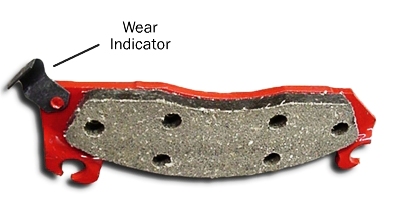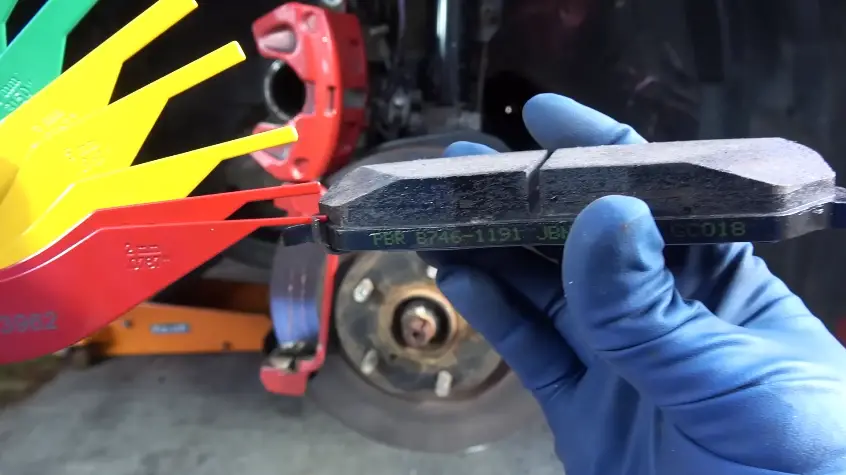The brake pad wear indicator sound is a high-pitched squealing or screeching noise that occurs when the brake pads have worn down to a certain level. This sound is caused by a metal tab, or sometimes an electronic sensor, making contact with the rotor to alert the driver that the brake pads need replacement.
Your vehicle’s braking system is one of the most crucial components for your safety. It enables you to stop or slow down your car when necessary, avoiding accidents and ensuring smooth driving. A key element within this system is the brake pads, which are designed to press against the rotors and create friction to stop the wheels from spinning. Over time, brake pads naturally wear down, reducing their efficiency and safety.
One of the most effective ways to know when your brake pads are wearing thin is through the brake pad wear indicator sound. This high-pitched squealing or screeching sound serves as an audible warning that your brake pads need immediate attention. But what exactly is this sound, why does it occur, and how should you respond when you hear it?
In this blog post, we’ll dive deep into the workings of brake pad wear indicators and how to properly address them.

What is a Brake Pad Wear Indicator?
A brake pad wear indicator is a small but critical component designed to alert you when your brake pads have worn down to a level where they are no longer safe to use. This wear indicator can either be mechanical or electronic, and its purpose is to prevent your brake pads from wearing down to the point of failure, which could result in damage to your rotors or other parts of your braking system.
1. Mechanical Wear Indicators
A mechanical wear indicator is a small metal tab built into the brake pad. As the brake pad material wears down over time, the tab eventually makes contact with the rotor. This contact produces a high-pitched, squealing sound when the brakes are applied, signaling that your brake pads are nearing the end of their lifespan.
2. Electronic Wear Indicators
In modern vehicles, some brake systems come equipped with electronic wear sensors. These sensors are embedded within the brake pads, and when the pad material wears down to a certain level, the sensor sends a signal to the vehicle’s computer, triggering a warning light on the dashboard.
While electronic wear indicators are more technologically advanced and can give an early alert before reaching a critical level, mechanical indicators are still quite common and effective in notifying drivers of worn brake pads.
What Causes the Brake Pad Wear Indicator Sound?
The squealing noise produced by mechanical wear indicators can be alarming, but it’s meant to get the attention. Here’s how and why the sound occurs:
- Material Contact: As mentioned earlier, mechanical wear indicators are metal tabs that scrape against the rotor when the brake pad material becomes thin. The scraping creates a sharp, high-pitched sound when you apply the brakes. This is a deliberate design feature to ensure that drivers know their brake pads are worn out and need to be replaced.
- Consistent Squealing: The noise produced by the wear indicator usually becomes more consistent as the pads wear further. If you hear this sound regularly while braking, it’s important to have your brake pads inspected as soon as possible.
- Heat and Friction: In some cases, the sound can be amplified when brakes get hotter. This is due to the increased friction between the wear indicator and the rotor. Ignoring this warning can lead to further damage, such as scoring on the rotors, which would require more costly repairs.

Why Ignoring the Sound is Dangerous
Ignoring the brake pad wear indicator sound can lead to severe consequences for your vehicle and your safety. Here’s why it’s crucial to address this issue promptly:
- Decreased Braking Efficiency: As the brake pads wear thinner, they become less effective at generating the friction needed to stop the vehicle. This leads to longer stopping distances, which can be dangerous, especially in emergency situations.
- Damage to Rotors: When the wear indicator sound is ignored, the brake pads continue to wear until the metal backing of the pad comes into direct contact with the rotor. This metal-to-metal contact can cause deep grooves in the rotors, which will require resurfacing or even replacement—a far more expensive repair than simply replacing the brake pads.
- Increased Risk of Brake Failure: In extreme cases, completely worn-out brake pads can lead to brake failure, putting you at risk of losing control of your vehicle.
Steps to Take When Hear the Brake Pad Wear Indicator Sound
When you hear the brake pad wear indicator sound, it’s important not to panic but to take immediate action. Here’s what you should do:
1. Inspect Brake Pads
First, have your brake pads inspected by a professional mechanic. Most mechanics can quickly tell whether the sound is due to worn pads or if something else is causing the noise. In some cases, dirt or debris caught between the brake pad and rotor can also produce a squealing sound.
2. Replace the Brake Pads
If the pads are indeed worn out, they will need to be replaced. It’s advisable to replace both the front and rear pads at the same time to maintain balanced braking performance. While some people opt for DIY brake pad replacement, it’s often safer to leave this task to professionals, as improper installation can lead to further problems.
3. Check for Rotor Damage
If you’ve ignored the sound for too long, there’s a chance your rotors might also be damaged. The mechanic will check the rotors for grooves or scoring, and if necessary, resurface or replace them.
4. Consider Upgrading Brake Pads
When replacing your brake pads, you can also consider upgrading to a different material, depending on your driving habits. For example, ceramic brake pads last longer and provide better performance in high-temperature conditions, while semi-metallic pads offer excellent stopping power and durability at a lower cost.
Preventive Maintenance for Brakes
The best way to avoid brake problems and the wear indicator sound is through regular maintenance. Here are a few tips for keeping your brakes in optimal condition:
- Regular Inspections: Have your brake pads and rotors inspected at least once a year, or every 12,000 miles, whichever comes first. This ensures that any wear is caught early before it becomes a bigger issue.
- Avoid Aggressive Braking: Sudden stops and aggressive driving can accelerate brake pad wear. Try to brake smoothly and gradually when possible.
- Keep the Brake Fluid in Check: Low brake fluid can reduce the effectiveness of the brakes. Regularly check your brake fluid level and have it replaced according to the manufacturer’s recommendations.
Frequently Asked Questions
Here are some FAQs about brake pad wear indicator sound –
What does the brake pad wear indicator sound like?
The brake pad wear indicator sound is typically a high-pitched squealing or screeching noise that occurs when you apply the brakes. It’s caused by a metal tab scraping against the rotor as the brake pads wear down.
Is it safe to drive with a brake pad wear indicator sound?
While it may be safe to drive for a short period, you should have your brakes inspected as soon as possible. Ignoring the sound can lead to more serious issues like rotor damage or brake failure.
Can the wear indicator sound occur even if the brake pads aren’t worn out?
Yes, in some cases, dirt, rust, or debris caught between the brake pad and rotor can create a similar noise. However, it’s best to have the brakes checked to rule out any serious issues.
How often should I replace my brake pads?
On average, brake pads last between 30,000 and 70,000 miles, depending on driving conditions, brake pad material, and driving habits. Your vehicle’s manual should give more specific guidelines.
What happens if I ignore the brake pad wear indicator?
Ignoring the sound can lead to decreased braking efficiency, rotor damage, and even brake failure, resulting in more expensive repairs and posing a significant safety risk.
Conclusion
The brake pad wear indicator sound is your vehicle’s way of telling you that it’s time to replace your brake pads. While the noise may be irritating, it’s a crucial alert that should not be ignored. Regular brake inspections, smooth driving habits, and timely brake pad replacement can help ensure that your brakes remain in optimal condition, keeping you safe on the road.